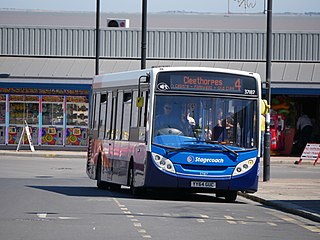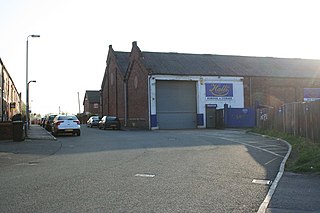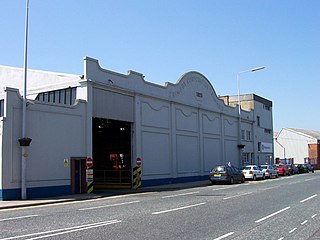
The Kingston upon Hull tramway network was a network of 4 ft 8+1⁄2 instandard gauge tram lines following the five main roads radially out of the city centre of Kingston upon Hull, East Riding of Yorkshire, England. Two of these lines went west, and two east. The fifth went to the north, and branched to include extra lines serving suburban areas. Additionally a short line linked the city centre to the Corporation Pier where a ferry crossed the Humber Estuary to New Holland, Lincolnshire.
Birmingham City Transport was the local authority-owned undertaking that provided road-based public transport in Birmingham, England, between 1899 and 1969. It was locally known as the Corporation Buses. Initially, it was called Birmingham Corporation Tramways, and, after the first motor bus services started in July 1914, it became Birmingham Corporation Tramways and Omnibus Department in 1928. Finally, in November 1937, it was renamed "Birmingham City Transport", though Birmingham itself had been a City since 1889. It was incorporated into the West Midlands Passenger Transport Executive in 1969.

Stagecoach Grimsby-Cleethorpes is a subdivision of Stagecoach East Midlands that operates buses in and around North East Lincolnshire, England, serving a population of over 150,000. It runs town services in its main hubs of Grimsby and Cleethorpes, as well as services to Immingham and nearby villages. Buses operate via the Riverhead bus station, opened in 1989, which is situated next to the Freshney Place Shopping Centre in Grimsby town centre.
The Mexborough and Swinton Traction Company was the name adopted by the Mexborough & Swinton Tramways Company in 1929 following the introduction of trolleybuses on all its routes. It operated in the West Riding of Yorkshire, England, over routes serving Manvers Main Colliery, Wath upon Dearne and the towns of Rotherham, Rawmarsh, Swinton, Mexborough, Conisbrough and the estate at Conanby.

The Wolverhampton trolleybus system served the city of Wolverhampton, then in Staffordshire, England, for much of the twentieth century.

The Rotherham trolleybus system once served the town of Rotherham, West Riding of Yorkshire, England. Opened on 3 October 1912, it was the fourth trolleybus system to be established in the United Kingdom, after the systems in nearby Bradford and Leeds, which had opened simultaneously in 1911, and Dundee earlier in 1912. Between 1912 and 1949, the Rotherham system gradually replaced the Rotherham Tramway.

The Nottingham trolleybus system once served the city of Nottingham, in the county of Nottinghamshire, England. Opened on 10 April 1927, it gradually replaced the Nottingham tramway network.

The Reading trolleybus system served the town of Reading in the English county of Berkshire and was owned by Reading Corporation, who had operated an electric tramway since 1901. As there was a need for major refurbishment of the tramway in the 1930s, they decided to replace it with a trolleybus network. The first route was converted on 18 July 1936, and by mid 1939, trolleybuses were running over most of the tramway routes, with the last tram running on 20 May. By the standards of the various now-defunct trolleybus systems in the United Kingdom, the Reading system was a moderately sized one, with a total of four routes, and a maximum fleet of 63 trolleybuses, a size that lasted from 1 December 1950 to 27 March 1952.

The Walsall trolleybus system once served the town of Walsall, then in Staffordshire, but now in West Midlands, England. Opened on 22 July 1931, it gradually replaced the Walsall Corporation Tramways network.

The Grimsby trolleybus system once served the seaport of Grimsby, in Lincolnshire, England. Opened on 3 October 1926, it gradually replaced part of the Great Grimsby Street Tramways, a tramway that had served both Grimsby and the neighbouring holiday resort of Cleethorpes. It was closed on 4 June 1960.

The Cleethorpes trolleybus system once served the holiday resort of Cleethorpes, in Lincolnshire, England. Opened on 18 July 1937, it replaced part of the Great Grimsby Street Tramways, a tramway that had served both Cleethorpes and the neighbouring seaport of Grimsby. It was closed on 4 June 1960.

The Doncaster trolleybus system once served the town of Doncaster, South Yorkshire, England. Opened on 22 August 1928, it gradually replaced the Doncaster Corporation Tramways. By the standards of the various now-defunct trolleybus systems in the United Kingdom, the Doncaster system was a moderately sized one, with a total of 6 routes, all radiating out from the town centre, and a maximum fleet of 47 trolleybuses. The Bentley route was the first to close, on 12 February 1956, and the Beckett Road route was the last to go, on 14 December 1963.
The South Lancashire trolleybus system once served towns in South Lancashire, England, including Atherton, Bolton, Swinton and Leigh and St Helens. Opened on 3 August 1930, it replaced the South Lancashire Tramways network.
The Southend-on-Sea trolleybus system once served the town of Southend-on-Sea, in Essex, England. Opened on 16 October 1925, it gradually replaced Southend-on-Sea Corporation Tramways.

Wigan Corporation Tramways operated a tramway service in Wigan, England, between 1901 and 1931. The first tramway service in the town was run by the Wigan Tramways Company, whose horse trams began carrying passengers in 1880. They began replacing horses with steam tram locomotives from 1882, but the company failed in 1890 when a Receiver was appointed to manage it. The Wigan & District Tramways Company took over the system in 1893 and ran it until 1902. Meanwhile, Wigan Corporation were planning their own tramway system, obtaining an authorising Act of Parliament in 1893, and a second one in 1898. This enabled them to build electric tramways, and in 1902, they took over the lines of the Wigan & District Tramways Company.
Pontypridd Urban District Council Tramways operated a tramway service in Pontypridd between 1904 and 1931. Part of it used the route of the Pontypridd and Rhondda Valley Tramway Company's horse tramway. Between 1919 and 1927, it was the only system in Wales where through running onto a neighbouring system occurred. In 1930, part of the system was converted to use trolleybuses, and the former horse tramway section was replaced by motor buses in 1931, bringing the tramway era to an end. During the Second World War, a number of trolleybuses were borrowed from other systems, to cope with heavy traffic, but the use of electric vehicles ended in 1957. Most of the vehicles were sold on to other undertakings, and the system was the last in Britain to be run by an Urban District Council.
Halifax Corporation Tramways operated a tramway service in Halifax, West Yorkshire, England between 1898 and 1939. After considering lifts and inclined planes to assist trams in negotiating the steep hills to the south of the town, they obtained permission to build a conventional system in 1897, and the first three routes opened in 1898. By 1905 there were 37 miles (60 km) of track and 96 tramcars, supplied by two manufacturers. In 1921, an additional route was added to the system, and the Corporation embarked on a programme of building their own tramcars, some of which replaced existing vehicles, while some extended the fleet. During the 1930s, the trams were gradually replaced by motor buses, either run by the Corporation or by private companies, and the last tram ran on 14 February 1939.

The Oldham trolleybus system once served the town of Oldham, then in Lancashire, but now in Greater Manchester, England.

The Great Grimsby Street Tramways Company was a tramway serving Grimsby and Cleethorpes in Lincolnshire, England. It was a subsidiary of The Provincial Tramways Company. They opened a horse tramway in 1881, running from the Wheatsheaf Inn in Bargate to the border with Cleethorpes, with a branch along Freeman Street, and extended the line into Cleethorpes in 1887. It followed the trend of many British systems, and was converted to an electric tramway in December 1901. Small extensions were made to the system at both ends, but the basic plan of the system remained the same throughout its life.
Bradford Corporation Tramways were a tramway network in the city of Bradford, West Riding of Yorkshire, England which operated trams from 1882 until 1950 and trolleybuses from 1911 until 1972. The track gauge of the tramways was 4 ft.














